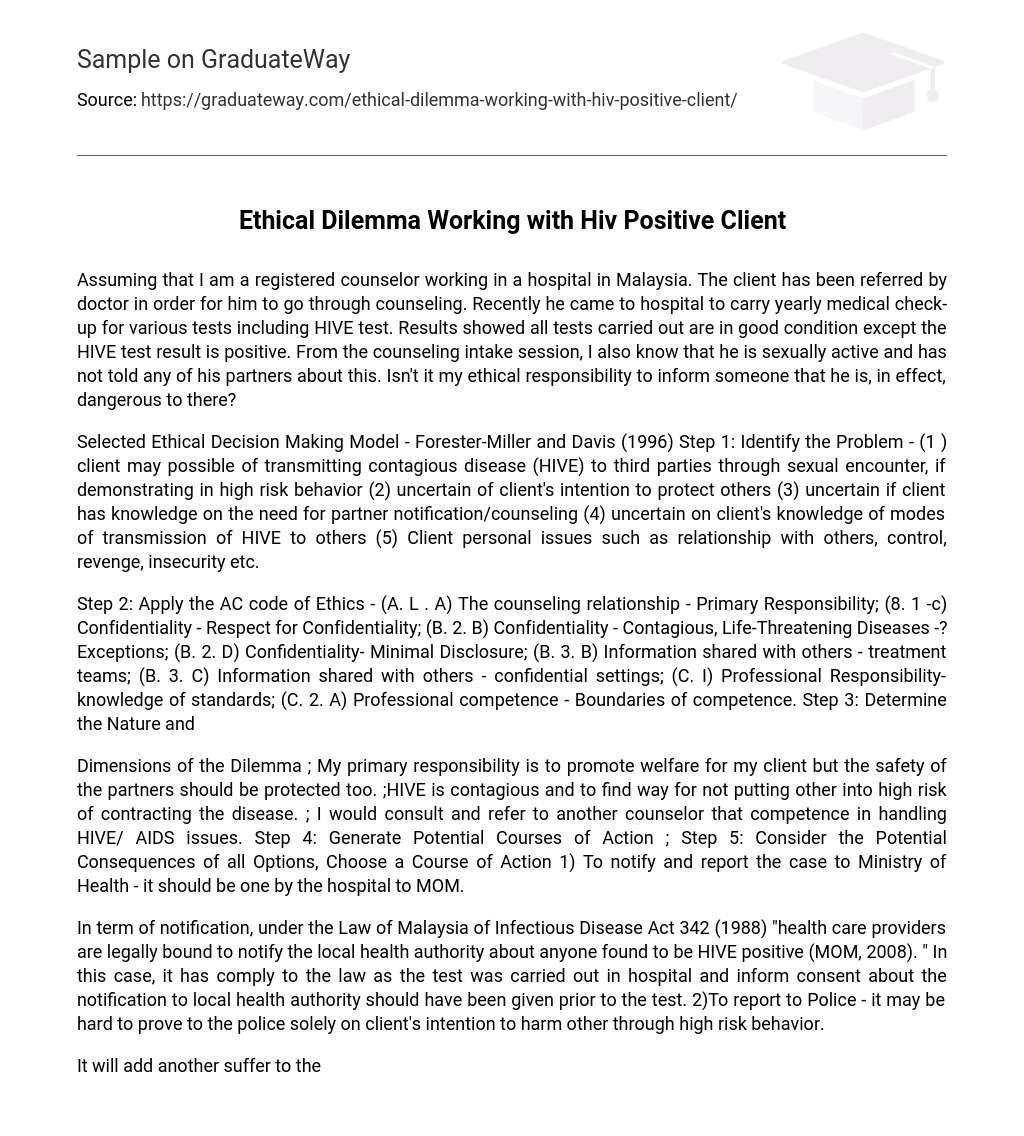Assuming that I am a registered counselor working in a hospital in Malaysia. The client has been referred by doctor in order for him to go through counseling. Recently he came to hospital to carry yearly medical check-up for various tests including HIVE test. Results showed all tests carried out are in good condition except the HIVE test result is positive. From the counseling intake session, I also know that he is sexually active and has not told any of his partners about this. Isn’t it my ethical responsibility to inform someone that he is, in effect, dangerous to there?
Selected Ethical Decision Making Model – Forester-Miller and Davis (1996) Step 1: Identify the Problem – (1 ) client may possible of transmitting contagious disease (HIVE) to third parties through sexual encounter, if demonstrating in high risk behavior (2) uncertain of client’s intention to protect others (3) uncertain if client has knowledge on the need for partner notification/counseling (4) uncertain on client’s knowledge of modes of transmission of HIVE to others (5) Client personal issues such as relationship with others, control, revenge, insecurity etc.
Step 2: Apply the AC code of Ethics – (A. L . A) The counseling relationship – Primary Responsibility; (8. 1 -c) Confidentiality – Respect for Confidentiality; (B. 2. B) Confidentiality – Contagious, Life-Threatening Diseases -? Exceptions; (B. 2. D) Confidentiality- Minimal Disclosure; (B. 3. B) Information shared with others – treatment teams; (B. 3. C) Information shared with others – confidential settings; (C. I) Professional Responsibility- knowledge of standards; (C. 2. A) Professional competence – Boundaries of competence. Step 3: Determine the Nature and
Dimensions of the Dilemma ; My primary responsibility is to promote welfare for my client but the safety of the partners should be protected too. ;HIVE is contagious and to find way for not putting other into high risk of contracting the disease. ; I would consult and refer to another counselor that competence in handling HIVE/ AIDS issues. Step 4: Generate Potential Courses of Action ; Step 5: Consider the Potential Consequences of all Options, Choose a Course of Action 1) To notify and report the case to Ministry of Health – it should be one by the hospital to MOM.
In term of notification, under the Law of Malaysia of Infectious Disease Act 342 (1988) “health care providers are legally bound to notify the local health authority about anyone found to be HIVE positive (MOM, 2008). ” In this case, it has comply to the law as the test was carried out in hospital and inform consent about the notification to local health authority should have been given prior to the test. 2)To report to Police – it may be hard to prove to the police solely on client’s intention to harm other through high risk behavior.
It will add another suffer to the client, if the client does not has intention to harm to others. 3) To get name and contact of the client’s partners – client may not want or give false or do not have the partners’ contact. We may loss the client if he is not voluntary inform partners, as the client may not want to attend the subsequent counseling session anymore. This would loss the opportunity to do HIVE prevention works. Therefore according to UNAIDED (2000), it is encouraged voluntary disclosure of HIVE status and ethical partner notification and counseling. To counsel client and provide information on the importance and benefit of notification, provides HIVE prevention knowledge and support available. To counsel client if there are underlying personal, relationship and emotion issues and possible of violent that hinder him on the dilemma on notification to others. – According to UNAIDED (2000), ‘the fear and taboos associated with these subjects lead to the denial, stigma and discrimination that surround HIVE/AIDS, and breed the secrecy that hinder private and community discussion about the issues and behavior involved. Step 6: Evaluate the Selected Course of Action – I would begin counseling session for him by understanding his response and concerns in knowing his HIVE status. Then I will choose the course of action as stated in item (4) in step 5. Step 7: Implement the Course of Action – It is counselor duty to protect and according to UNAIDED (2000) guideline, in cases where the client refuses to notify, following repeated efforts to persuade him to do so, and where the failure to notify creates a danger to a partner (an identifiable third party), would be authorized to counsel the partner(s) without the consent of the client.
However, it also states that in making this decision, I should ensure that the following factors are present: (1) Client has been thoroughly counseled as to the need for partner notification/counseling; (2) The counseling has failed to achieve the appropriate behavioral changes, including the practice of safe sex; (3) The client refused to notify, or consent to the counseling, of his partner(s); (4) A real risk of HIVE transmission to the identifiable partner(s) exists; (5) The client is given reasonable advance notice of the intention to counsel by the health care worker; (6) The identity of the source client is concealed from the partner(s) if this is possible in practice, (7) Follow-up is provided to ensure support to those involved as necessary and to prevent violence, family disruption. (8) If client shows his intention and make harm other such as sharing needle, or having unprotected sex, he is can be committing “criminal transmission of HIVE” and I shall consider report to Police.





